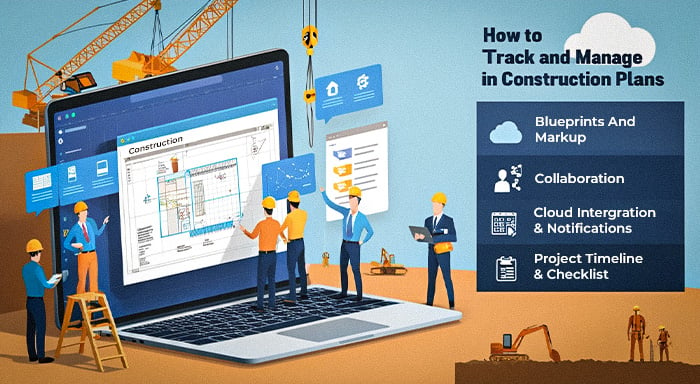Construction projects are dynamic endeavors. Plans continuously change, unexpected challenges come up, and adaptations become significant. Monitoring these is extremely important for the overall success of the project. This guide covers efficient strategies for handling all kinds of modifications in the construction strategies. It showcases the role of cutting-edge construction drawing management tools in simplifying the process.
Construction projects rarely proceed exactly as initially planned. Major problems occur such as material shortages, weather disruptions, design revisions, and unpredictable site conditions, creating the need for suitable adjustments. Without a systematic approach to tracking these changes, projects risk delays, budget overruns, and quality issues.
Effective change management in construction involves more than just updating drawings. It needs thorough communication, comprehensive documentation, and a smart approach to predicting potential impacts. By executing robust monitoring systems and incorporating key technology, construction teams can implement these changes more smoothly, reducing disruptions and maintaining overall momentum in the project.
This article deeply explores practical strategies for handling all the changes in the construction plan. In this article, let us explore the top practices for documenting modifications, giving updates to stakeholders, and leveraging online tools to simplify the process. Irrespective of whether you are an expert project manager or a newcomer in this field, you will get useful insights to improve your approach toward change management.
Creating a Solid Foundation for Ensuring Change Management
Before going deep into particular tracking methods, it is important to create the foundations for streamlined change management in different construction projects. These foundations then set the stage for project managers to easily handle modifications throughout the lifecycle of the project.
Clear Contract Terms and Scope Definition
Start by crafting precise contract language that outlines the change order process. This should include:
- Timelines for submitting and approving changes
- Required documentation for change requests
- Procedures for cost estimation and approval
- Impact assessment guidelines
A well-defined scope of work in the original contract serves as a crucial reference point. It helps differentiate between genuine changes and work that falls within the agreed-upon scope.
Proactive Issue Identification
Before breaking ground, conduct a thorough review of project plans and specifications. Look for:
- Potential ambiguities or contradictions
- Areas where additional clarification might be needed
- Possible design conflicts or constructability issues
Addressing these concerns early can prevent unnecessary changes later in the project.
Establishing a Change Management Process
Develop a standardized procedure for handling changes. This must comprise of:
- A clear chain of command for change approvals
- Templates for change request documentation
- A system for tracking the status of pending changes
- Guidelines for assessing the impact of proposed modifications
By having these elements in place from the outset, you create a structured approach to managing inevitable project adjustments.
Leveraging Technology for Efficient Change Tracking
In today's digital age, construction teams have powerful tools at their disposal for managing project changes. Premier’s construction drawing management software plays a pivotal role in streamlining the process.
Benefits of Digital Change Management
Implementing specialized software offers numerous advantages:
- Real-time updates and collaboration
- Centralized document storage and version control
- Automated notifications for pending approvals
- Integration with project scheduling and budgeting tools
These characteristics improve communication, minimize errors, and ensure a clear audit trail for all kinds of modifications in a project.
Key Features to Look for in Construction Drawing Management Software
When selecting a software solution, prioritize these capabilities:
- Cloud-based access for remote team members
- Mobile compatibility for on-site updates
- Markup tools for easy annotation of drawings
- Integration with Building Information Modeling (BIM) systems
- Robust search functionality for quick document retrieval
Implementing Digital Tools Effectively
To maximize the benefits of construction drawing management software:
- Provide thorough training for all team members
- Establish clear protocols for using the system
- Regularly back up data and perform software updates
- Customize the software to align with your specific workflow
By fully embracing these digital tools, construction teams can significantly enhance their ability to track and manage project changes efficiently.
Documenting Changes with Precision
Accurate and thorough documentation forms the backbone of effective change management in construction projects. Properly keeping all the records not only ensures a seamless execution of the project but also protects you in case any disputes happen.
Essential Elements of Change Documentation
When recording modifications to construction plans, include:
- Detailed description of the proposed change
- Reason for the modification
- Estimated cost impact
- Schedule implications
- Required materials or resources
- Affected project areas or systems
- Approval signatures from relevant parties
Maintaining this level of detail for each change creates a comprehensive project history.
Utilizing Change Order Forms
Standardized change order forms streamline the documentation process. Key components should include:
- Unique change order number
- Project name and contract reference
- Date of request and proposed implementation
- Space for detailed change description
- Cost breakdown
- Schedule impact assessment
- Approval signature lines
Digital forms integrated with your construction drawing management software can automate much of this process, reducing administrative burden.
Creating a Change Order Log
Maintain a centralized log of all project changes. This should track:
- Change order status (pending, approved, rejected)
- Submission and approval dates
- Brief description of each change
- Associated costs
- Cumulative impact on project budget and timeline
Regularly reviewing this log helps project managers stay ahead of potential issues and keep stakeholders informed.
Communicating Changes Effectively
Clear, timely communication is crucial when managing construction plan modifications. Allowing stakeholders to be updated from time to time helps in minimizing miscommunication and misunderstanding. This makes sure that the project progresses as smoothly as possible.
Establishing Communication Protocols
Develop a structured approach to sharing change information:
- Identify key stakeholders who need to be informed of changes
- Determine appropriate communication channels (e.g., email, project management software, in-person meetings)
- Set expectations for response times and approval processes
- Create templates for change notifications to ensure consistency
These protocols provide a framework for efficient information sharing.
Leveraging Visual Communication Tools
Visual aids can greatly enhance understanding of proposed changes:
- Use annotated drawings or 3D models to illustrate modifications
- Create before-and-after comparisons to highlight differences
- Employ color-coding to indicate change categories or priority levels
Construction drawing management software often includes tools for creating these visual representations, making it easier to convey complex information.
Conducting Regular Change Review Meetings
Schedule periodic meetings dedicated to discussing project modifications:
- Review pending and recently approved changes
- Assess potential impacts on project timeline and budget
- Discuss any challenges in implementing changes
- Gather feedback from team members and stakeholders
These meetings ensure total collaboration and ascertain that everyone is aligned with the project development.
Evaluating the Overall Impact of Changes
Ensuring an in-depth evaluation of the consequences of suggested changes is vital for data-driven decision-making and successful project execution.
Analyzing Cost Implications
When assessing a change's financial impact, consider:
- Direct material and labor costs
- Potential ripple effects on other project areas
- Long-term maintenance or operational cost changes
- Impact on project cash flow
Utilize your construction drawing management software's cost-tracking features to perform detailed analysis and generate reports.
Assessing Schedule Effects
Changes can greatly impact the timelines of the project. Evaluate:
- Duration of implementing the change itself
- Knock-on effects on subsequent tasks
- Potential conflicts with other scheduled activities
- Impact on critical path milestones
Integrate change assessments with your project scheduling software to visualize timeline adjustments.
Considering Quality and Safety Implications
Beyond cost and schedule, evaluate how changes might affect:
- Overall build quality
- Compliance with building codes and regulations
- Site safety during implementation
- Long-term structural integrity or performance
Consult with relevant experts (e.g., engineers, and safety officers) when assessing these factors.
Implementing Changes Efficiently
Once a change has been approved, executing it smoothly is key to minimizing disruption and maintaining project momentum.
Updating Project Documentation
Promptly revise all relevant project documents, including:
- Construction drawings
- Specifications
- Work schedules
- Material orders
- Subcontractor agreements
Use version control features in your construction drawing management software to track revisions and ensure all team members are working from the most current information.
Coordinating with Affected Parties
Identify all stakeholders impacted by the change and:
- Conduct briefings to explain the modification and its implications
- Provide updated drawings or specifications as needed
- Address any concerns or questions
- Adjust work assignments or schedules as necessary
Clear communication at this stage helps prevent misunderstandings and keeps the project running smoothly.
Monitoring Change Implementation
Closely track the execution of approved changes:
- Assign a team member to oversee the implementation
- Establish checkpoints to assess progress
- Compare actual costs and timelines against estimates
- Address any unexpected issues promptly
Regular monitoring allows for quick adjustments if needed and helps keep the change process on track.
Improving from Change Management Experiences
Each project is rich with valuable lessons that help construction managers refine their change management practices for future projects. Taking some time to reflect on past mistakes and analyzing them can lead to improved processes and smarter decision-making in the coming projects.
Conducting Post-Project Reviews
After project completion, hold a dedicated session to discuss change management:
- Review the volume and types of changes encountered
- Assess the effectiveness of your tracking and communication methods
- Identify any recurring issues or patterns
- Gather feedback from team members and stakeholders
Such insights can lead to data-driven and smarter process improvements and aid in predicting challenges in the next projects.
Updating Best Practices
Based on your project experiences:
- Refine your change order templates and forms
- Adjust approval processes to address any bottlenecks
- Enhance your construction drawing management software usage
- Develop new training materials for team members
Continuously evolving your approach keeps your change management strategies sharp and effective.
Sharing Knowledge Across the Organization
Disseminate lessons learned to benefit the entire company:
- Create case studies highlighting successful change management examples
- Conduct workshops to share insights and best practices
- Update company-wide policies and procedures based on project experiences
This knowledge-sharing fosters a culture of continuous improvement in change management practices.
Conclusion
By executing these strategies and incorporating powerful platforms like construction drawing software, construction teams can implement changes in the project more effectively. This proactive strategy is vital for reducing disruptions, controlling costs, and ensuring desired outcomes in a project. The blog explores the importance of technology in effective change management and mentions practical tips for the disruption-free implementation of these changes.
Related Post:
Strengthening Your Human Resource Strategy with Top 26 HRMS Tools for 2025









